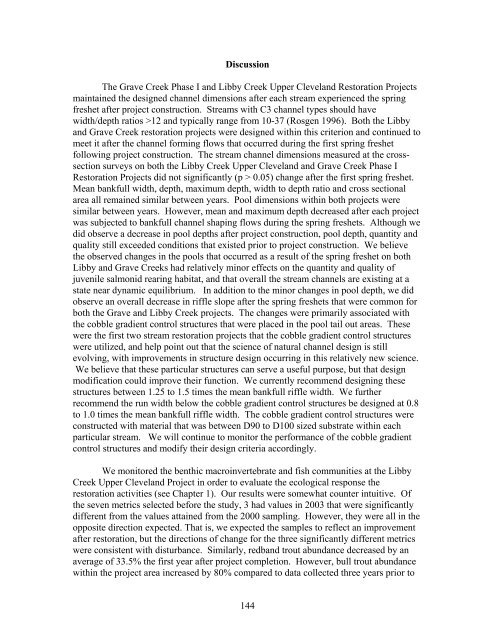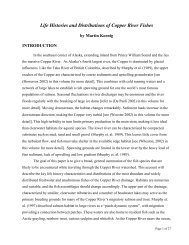Mitigation for the Construction and Operation of Libby Dam
Mitigation for the Construction and Operation of Libby Dam
Mitigation for the Construction and Operation of Libby Dam
Create successful ePaper yourself
Turn your PDF publications into a flip-book with our unique Google optimized e-Paper software.
Discussion<br />
The Grave Creek Phase I <strong>and</strong> <strong>Libby</strong> Creek Upper Clevel<strong>and</strong> Restoration Projects<br />
maintained <strong>the</strong> designed channel dimensions after each stream experienced <strong>the</strong> spring<br />
freshet after project construction. Streams with C3 channel types should have<br />
width/depth ratios >12 <strong>and</strong> typically range from 10-37 (Rosgen 1996). Both <strong>the</strong> <strong>Libby</strong><br />
<strong>and</strong> Grave Creek restoration projects were designed within this criterion <strong>and</strong> continued to<br />
meet it after <strong>the</strong> channel <strong>for</strong>ming flows that occurred during <strong>the</strong> first spring freshet<br />
following project construction. The stream channel dimensions measured at <strong>the</strong> crosssection<br />
surveys on both <strong>the</strong> <strong>Libby</strong> Creek Upper Clevel<strong>and</strong> <strong>and</strong> Grave Creek Phase I<br />
Restoration Projects did not significantly (p > 0.05) change after <strong>the</strong> first spring freshet.<br />
Mean bankfull width, depth, maximum depth, width to depth ratio <strong>and</strong> cross sectional<br />
area all remained similar between years. Pool dimensions within both projects were<br />
similar between years. However, mean <strong>and</strong> maximum depth decreased after each project<br />
was subjected to bankfull channel shaping flows during <strong>the</strong> spring freshets. Although we<br />
did observe a decrease in pool depths after project construction, pool depth, quantity <strong>and</strong><br />
quality still exceeded conditions that existed prior to project construction. We believe<br />
<strong>the</strong> observed changes in <strong>the</strong> pools that occurred as a result <strong>of</strong> <strong>the</strong> spring freshet on both<br />
<strong>Libby</strong> <strong>and</strong> Grave Creeks had relatively minor effects on <strong>the</strong> quantity <strong>and</strong> quality <strong>of</strong><br />
juvenile salmonid rearing habitat, <strong>and</strong> that overall <strong>the</strong> stream channels are existing at a<br />
state near dynamic equilibrium. In addition to <strong>the</strong> minor changes in pool depth, we did<br />
observe an overall decrease in riffle slope after <strong>the</strong> spring freshets that were common <strong>for</strong><br />
both <strong>the</strong> Grave <strong>and</strong> <strong>Libby</strong> Creek projects. The changes were primarily associated with<br />
<strong>the</strong> cobble gradient control structures that were placed in <strong>the</strong> pool tail out areas. These<br />
were <strong>the</strong> first two stream restoration projects that <strong>the</strong> cobble gradient control structures<br />
were utilized, <strong>and</strong> help point out that <strong>the</strong> science <strong>of</strong> natural channel design is still<br />
evolving, with improvements in structure design occurring in this relatively new science.<br />
We believe that <strong>the</strong>se particular structures can serve a useful purpose, but that design<br />
modification could improve <strong>the</strong>ir function. We currently recommend designing <strong>the</strong>se<br />
structures between 1.25 to 1.5 times <strong>the</strong> mean bankfull riffle width. We fur<strong>the</strong>r<br />
recommend <strong>the</strong> run width below <strong>the</strong> cobble gradient control structures be designed at 0.8<br />
to 1.0 times <strong>the</strong> mean bankfull riffle width. The cobble gradient control structures were<br />
constructed with material that was between D90 to D100 sized substrate within each<br />
particular stream. We will continue to monitor <strong>the</strong> per<strong>for</strong>mance <strong>of</strong> <strong>the</strong> cobble gradient<br />
control structures <strong>and</strong> modify <strong>the</strong>ir design criteria accordingly.<br />
We monitored <strong>the</strong> benthic macroinvertebrate <strong>and</strong> fish communities at <strong>the</strong> <strong>Libby</strong><br />
Creek Upper Clevel<strong>and</strong> Project in order to evaluate <strong>the</strong> ecological response <strong>the</strong><br />
restoration activities (see Chapter 1). Our results were somewhat counter intuitive. Of<br />
<strong>the</strong> seven metrics selected be<strong>for</strong>e <strong>the</strong> study, 3 had values in 2003 that were significantly<br />
different from <strong>the</strong> values attained from <strong>the</strong> 2000 sampling. However, <strong>the</strong>y were all in <strong>the</strong><br />
opposite direction expected. That is, we expected <strong>the</strong> samples to reflect an improvement<br />
after restoration, but <strong>the</strong> directions <strong>of</strong> change <strong>for</strong> <strong>the</strong> three significantly different metrics<br />
were consistent with disturbance. Similarly, redb<strong>and</strong> trout abundance decreased by an<br />
average <strong>of</strong> 33.5% <strong>the</strong> first year after project completion. However, bull trout abundance<br />
within <strong>the</strong> project area increased by 80% compared to data collected three years prior to<br />
144
















